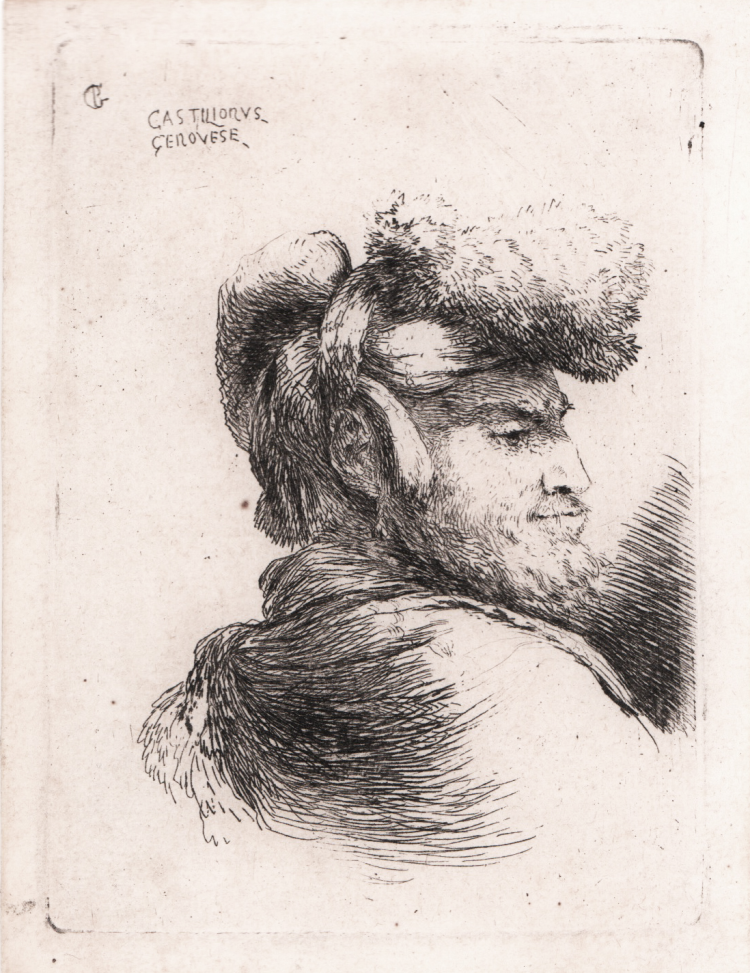




| Reference: | S46039 |
| Author | Giovanni Benedetto CASTIGLIONE detto "Il Grechetto" |
| Year: | 1645 |
| Measures: | 80 x 115 mm |



| Reference: | S46039 |
| Author | Giovanni Benedetto CASTIGLIONE detto "Il Grechetto" |
| Year: | 1645 |
| Measures: | 80 x 115 mm |
Etching, 1645-50 circa, with etched signature 'GB Castilione Genovese' at top left.
A good impression, printed on contemporary laid paper without watermark, with small margins, in excellent condition.
From the series Small Oriental heads, inspired to the parallel engravings of Rembrandt and Lievens. Rembrandt’s works were no doubt a great source of inspiration for this subject. The Genoese artist knew for sure the production of his Dutch colleague and, very likely, he also bought some of them. Castiglione’s graphic works present a close relationship with Rembrandt’s, both in style and subjects. Both used to engrave their plates with free strokes and both sought to achieve strong chiaroscuro contrasts in their prints.
Bibliografia
Bartsch, Le Peintre graveur (XXI.28.32); Bellini 1982, L'Opera incisa di Giovanni Benedetto Castiglione n. 23; TIB 032.
Giovanni Benedetto CASTIGLIONE detto "Il Grechetto" (Genova 1616 - Mantova 1670)
|
His origin and his edication in Genua led Castiglione to make acquaitance with the Flemish painting, especially through Jaan Roos e Van Dyck from whom he took the warm, vibrating chromatism.
He lived in Rome from 1632 to 1635 and from 1647 to 1651; among the two periods in Rome, he lived in Naples and he also started studying the intellectualistic classicism of Poussin.
His favourite subjects, both in painting and engraving, were taken from the classical moralism of Stoicism, very typical in Poussin, which enabled him to create his own peculiar repertoire, much more refined in comparison with contemporary artists.
He spent his last working years in Mantua, at the Duke’s Palace; the production of this period enhances his chromatism and the visionary elements of his previous production.
Castiglione has been a silful engraver; he loved this particular art for he thought it was the main mean to widespread his iconography. He was the first, in Italy, to appreciate and imitate Rembrandt.
|
Giovanni Benedetto CASTIGLIONE detto "Il Grechetto" (Genova 1616 - Mantova 1670)
|
His origin and his edication in Genua led Castiglione to make acquaitance with the Flemish painting, especially through Jaan Roos e Van Dyck from whom he took the warm, vibrating chromatism.
He lived in Rome from 1632 to 1635 and from 1647 to 1651; among the two periods in Rome, he lived in Naples and he also started studying the intellectualistic classicism of Poussin.
His favourite subjects, both in painting and engraving, were taken from the classical moralism of Stoicism, very typical in Poussin, which enabled him to create his own peculiar repertoire, much more refined in comparison with contemporary artists.
He spent his last working years in Mantua, at the Duke’s Palace; the production of this period enhances his chromatism and the visionary elements of his previous production.
Castiglione has been a silful engraver; he loved this particular art for he thought it was the main mean to widespread his iconography. He was the first, in Italy, to appreciate and imitate Rembrandt.
|